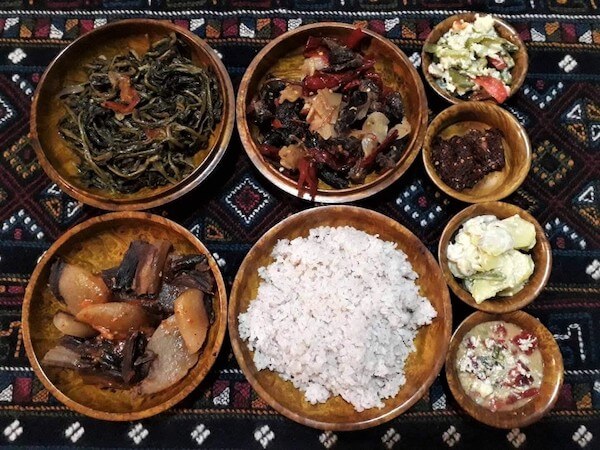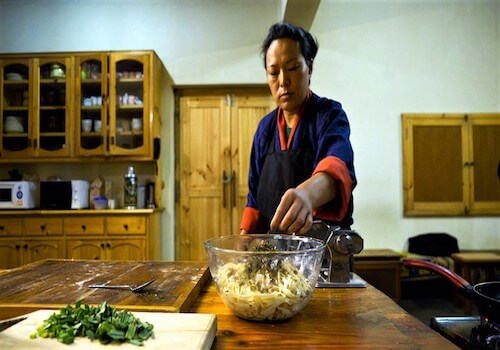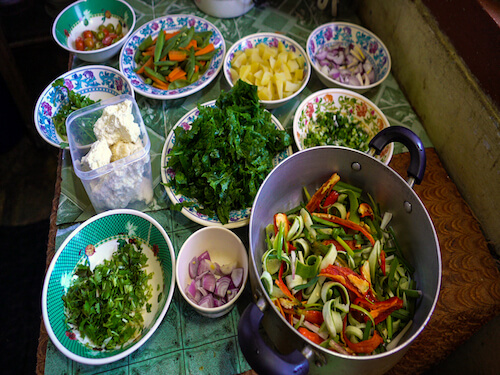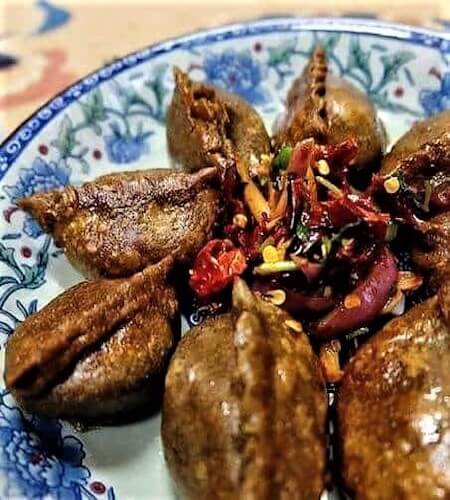 Shrouded in mystery in the eastern Himalayas, the magical Kingdom of Bhutan has a special place for food connoisseurs where food has its own sense of awakening. For appreciating Bhutanese cuisine, one should like hot, spicy food, meat fat and dried meat. However, the greatest passion of Bhutanese is for chillies. The number of ways in which locals use chillies or chilly powder in their cuisine defies imagination. One of the quite popular mouth burning Cuisine of Bhutan yet mouth watery dishes made of Chillies is Chilli-spiked 'Ezay' which resembles the Mexican ‘salsa’. 'Ezay' comprises chopped chillies, onions, cilantro, tomatoes and cheese. The other is raw chillies dipped in salt and served with a spring of green onions. An average Bhutanese family uses more than two or three dozen Chillies in a day.
Shrouded in mystery in the eastern Himalayas, the magical Kingdom of Bhutan has a special place for food connoisseurs where food has its own sense of awakening. For appreciating Bhutanese cuisine, one should like hot, spicy food, meat fat and dried meat. However, the greatest passion of Bhutanese is for chillies. The number of ways in which locals use chillies or chilly powder in their cuisine defies imagination. One of the quite popular mouth burning Cuisine of Bhutan yet mouth watery dishes made of Chillies is Chilli-spiked 'Ezay' which resembles the Mexican ‘salsa’. 'Ezay' comprises chopped chillies, onions, cilantro, tomatoes and cheese. The other is raw chillies dipped in salt and served with a spring of green onions. An average Bhutanese family uses more than two or three dozen Chillies in a day.
Rice plays an important role in the cuisine of the nation, much like most places around the Eastern Himalayan region. There are various types of rice in the country; white of southern Bhutan, red of Paro and a few other districts and yellow of Kharung – eastern Bhutan. Other grains are grown in certain areas of Bhutan, generally, those of the high Himalayas include buckwheat and barley. In central Bhutan, where the buckwheat is the special diet, delicacies made out of it are buckwheat noodles called 'Puta' and buckwheat momos called 'Hontay' which are filled with cheese (datshi) and vegetables such as spinach.
The use of Cheese or 'Datshi' is pretty common in Bhutanese cuisine. Curry which is taken with rice contains little meat or small bones. Bhutanese particularly like fresh pork or even better, dried. Beef and chicken are the second choices while mutton and lamb are eaten in small quantities. 'Pa' which is preferred to standard curry is made with large chunks of beef or yak meat, chilli, radish and spinach. Bhutanese love for meat is evident from the sight of beef or yak meat strips drying on lines or hanging from windows.
 Drinking milk is not a common habit in Bhutan and traditionally, milk has always been turned into butter and cheese called 'Datshi'. This cheese is not eaten raw but used to make sauces in which vegetables and meat are cooked. 'Churp' is another unbelievably hard cheese, made in yak breeding areas. The third kind and the most sought-after cheese comes from eastern Bhutan called 'Seudew' which is not eaten raw but mixed in small quantities into soup.
Drinking milk is not a common habit in Bhutan and traditionally, milk has always been turned into butter and cheese called 'Datshi'. This cheese is not eaten raw but used to make sauces in which vegetables and meat are cooked. 'Churp' is another unbelievably hard cheese, made in yak breeding areas. The third kind and the most sought-after cheese comes from eastern Bhutan called 'Seudew' which is not eaten raw but mixed in small quantities into soup.
Locals drink plenty of tea also either with milk and sugar called 'Nadja' or 'Seudja' – tea churned with salt and butter. The most popular local drink is 'Ara', made from wheat, barley, maize, buckwheat or rice. 'Chang' is a kind of national drink of Bhutan and consumed on a broad spectrum of occasions.
Some of the popular Bhutanese dishes are listed here:
Ema Datshi
Considered as the national dish of Bhutan, Ema Datshi is the most popular signature dish of the country made of 'Ema' (chilli) & 'Datshi' (cheese). It is typically eaten with red rice and no spices or herbs added to flavour the dish. Chilli & Cheese are the main ingredients for making this dish and any kind of chilli, red, green fresh or dried can be used while the variety of chilli used depends on the tolerance of the spiciness of the people eating the dish. For preparation, seeds of chilli are removed, and chillies are sliced lengthwise and cooked with cheese, also tossed up with butter to alter the spice quotient.
Kewa Datshi
'Kewa' is potato, and actually a milder version of Ema Datshi, Kewa Datshi is the perfect combination of potatoes & cheese. Easy to prepare but nourishing traditional dish, it is made with sliced potatoes stewed with cheese, onions, and chillies. The dish can be mild or hot, depending on the number of chillies added, but it is generally less hot than ema datshi.
Phaksha Paa
'Phasakha Paa', is basically pork cooked with spicy red chillies. Dried meat whether pork or yak is a staple food in Bhutanese cuisine. This dish is cooked with daikon or mild winter radish, bok choy, ginger, and fresh chillies and typically served over red or white rice. Nepal and Tibet have their own versions of Phaksha Paa, but neither of their varieties is spicier than the Bhutanese one. Whether prepared with fresh chilli or chilli powder, locals love this dish on the fiery side.
Shamu Datshi
Shamu datshi is a flavoured Bhutanese stew consisting of various types of mushrooms stewed in a combination of water, oil and green chillies. The preparation is quite similar to Ema Datshi & Kewa Datshi but the main ingredients in this dish changes to mushroom and in fact Shamu Datshi is the mildest variation amongst datshi family dishes. It is served with hot rice or crusty bread on the side.
 Shakam Datshi
Shakam Datshi
'Shakam' is dried beef which is among the most famous of meats. For Shakam Datshi, dried beef is diced into tiny pieces and cooked with generous amounts of cheese and butter. Instead of the local green peppers, white chillies are used in its preparation giving it a sour taste.
Jasha Maroo
'Jasha maroo' is a traditional Bhutanese dish, a friendly, flavourful mix of diced chicken, onion, garlic, ginger, tomatoes, coriander leaves, and chillies. This combination of ingredients is usually served on top of red or brown rice and along with fried potatoes. Jasha Maroo can also be served with heavier beef or beef brisket while vegetarians can opt to replace the meat with leafy greens. But the secret to this dish is in the richness of the chicken or beef stock. Jasha Maroo or just plain maru is one of the many stews available in Bhutan.
Shakam Paa
'Shakam Paa' is another popular Bhutanese dish in which the dried beef is simmered with potatoes, ginger and radishes. Traditionally cooked in a pot and served along with red rice, Shakam Paa is an excellent source of protein and is one of the staple diets of the locals. The technique of drying and preserving beef is also a part of the normal cooking style of Bhutan.
Yaksha Shakam
'Yaksha Shakam' is made of dried yak meat and is cooked in different ways. It can include yak cheese too. Yak meat is considered to be rich in natural oils and is a good source of protein, also low in fat & cholesterol.
Puta
'Puta' is the famous buckwheat noodles of Bumthang, a fascinating valley located in central Bhutan where buckwheat is grown and hence the place is the origin point of delicious buckwheat dishes. Puta is a complete meal in itself and healthy too. A good substitute for rice dishes, Puta is made by cooking these wheat noodles using sauces, vegetables, and meat. The noodles used in the dish are generally boiled however they are served stir-fried in oil.
Goen Hogay
Most of the Bhutanese dishes are pretty heavy with meat content but 'Goen Hogay' is one of the lightest local dishes. It is basically a cucumber salad mixed with red chillies, onions, tomatoes, coriander, spring onion and a crumble of Datshi (cheese). Some extra oil is also added to the recipe to give it a dressing like sauce.

Momos
One of the most widely eaten Asian food, Dumplings or momos are also an integral part of Bhutanese cuisine. A wide range of momos is served in the country depending upon fillings and that can include beef, pork, cheese, cabbage etc. These beautiful, little, steamed delights are traditionally eaten with spicy chutney, and at times served with a clear soup.
Hoentoe
'Hoentoe' is by far, one of the most delectable dishes originating from the exotic valley of Haa. The people of Haa, known as 'Haaps' in the local language, serve this traditional dish during Lomba – the New Year Festival celebrated in Haa and Paro. Hoentoe is a buckwheat dumpling stuffed with an assortment of ingredients that include dried spinach or turnip leaves, cottage cheese, butter, perilla seeds, ginger, clove and garlic. Hoentoe can be either steamed or fried and eaten with ezay, a chilli paste made from local dried chillies.
Suja
'Suja' or Butter tea is made with tea leaves, mountain herbs, fermented yak or cow butter & salt and is served traditionally with a basket of puffed rice known as zaow. The key ingredients that make suja distinct are yak butter and yak milk.
Jaju
'Jaju' is a side dish in Bhutanese cuisine and made with ingredients like Spinach, Dumroo, Bamboo shoot, Seaweed, Pumpkin or Bitter Gourd while the key ingredients of Jaju are Cheese and milk.
Ara
'Ara' is Bhutan’s very own traditional alcoholic drink made from rice, maize, millet or wheat and may be either fermented or distilled. The beverage is usually a clear, creamy, or white colour. Sometimes Ara is also heated with butter and eggs to make it a more wholesome beverage.